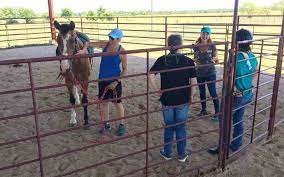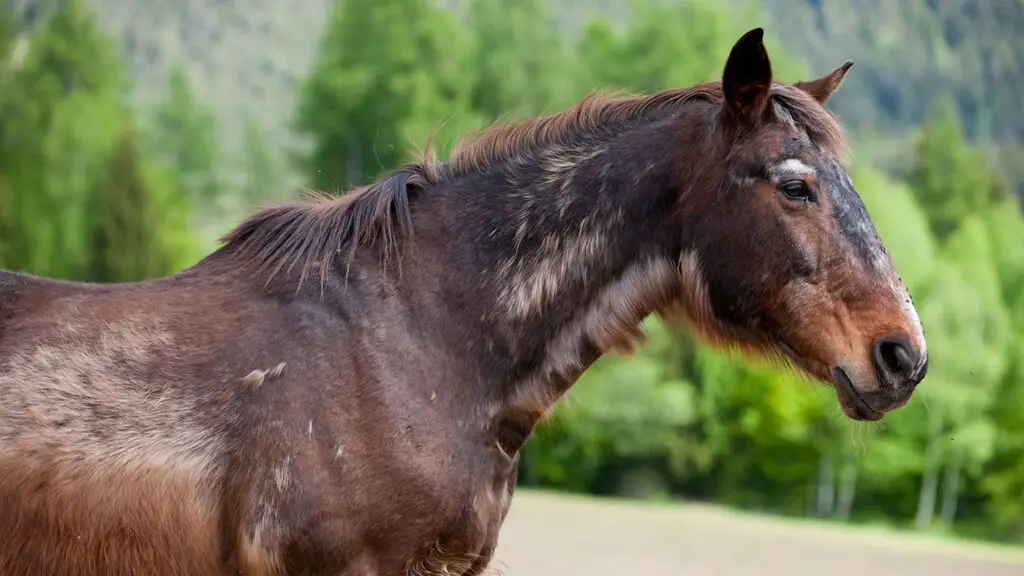Deciding when to euthanize a horse with Cushing’s disease can be an emotional and challenging decision for any horse owner. Cushing’s disease, also known as pituitary pars intermedia dysfunction (PPID), is a common hormonal disorder that affects horses. It causes the pituitary gland to produce excess stress hormones, particularly cortisol, leading to a range of symptoms and health issues. In this comprehensive guide, we will explore the factors to consider when faced with the question of euthanasia for a horse with Cushing’s. By understanding the disease, assessing the horse’s quality of life, consulting with veterinarians, and considering emotional and practical factors, you can make a compassionate and well-informed decision for your beloved equine companion.
Understanding Cushing’s Disease in Horses
Cushing’s disease, or pituitary pars intermedia dysfunction (PPID), is a hormonal disorder that primarily affects older horses. It occurs when the pituitary gland, located at the base of the brain, produces excessive amounts of hormones, including cortisol. The overproduction of cortisol disrupts the body’s normal functions and leads to various health problems. Common symptoms of Cushing’s disease include a long, curly coat, excessive sweating, weight loss, muscle wasting, laminitis, and a compromised immune system.
Assessing Quality of Life
When considering euthanasia for a horse with Cushing’s disease, it is essential to assess the horse’s overall quality of life. Monitor the horse’s well-being, pain levels, and ability to perform normal activities. Look for signs of distress, such as chronic lameness or recurring episodes of laminitis, which can significantly impact the horse’s comfort and mobility. Consult with your veterinarian to evaluate the horse’s response to treatments and management strategies. Consider whether the horse’s condition is progressively declining or if the disease is causing severe physical limitations.
Discussing with Your Veterinarian
Making the decision to euthanize a horse with Cushing’s disease is never easy, and seeking guidance from your veterinarian is crucial. Schedule a thorough discussion with your veterinarian to review the horse’s medical history, current condition, and treatment options. Your veterinarian can provide valuable insights into the horse’s prognosis and potential outcomes. Together, you can explore various treatment plans, evaluate their effectiveness, and determine if euthanasia is a humane choice for your horse.
Factors to Consider for Euthanasia
Several factors should be considered when contemplating euthanasia for a horse with Cushing’s disease. If the horse is experiencing unmanageable pain or suffering despite medical interventions, euthanasia may be the kindest option. Progressive decline in the horse’s quality of life, such as severe weight loss, chronic laminitis, or loss of bodily functions, can also indicate that euthanasia should be considered. Financial considerations and long-term care requirements should also be taken into account, as some horses with advanced Cushing’s disease may require costly and extensive care that may not be feasible or practical.
Consultation with Equine Specialists or Support Groups

In addition to consulting with your veterinarian, reaching out to equine specialists or joining support groups can provide valuable insights and support during this challenging time. Equine specialists, such as veterinary oncologists or palliative care experts, can offer expertise and alternative treatment options that may enhance the horse’s quality of life. Support groups and online communities provide a platform for sharing experiences, gaining emotional support, and learning from others who have faced similar decisions.
Emotional Considerations and Grief Support
Deciding to euthanize a horse with Cushing’s disease is emotionally distressing for any horse owner. It is essential to acknowledge and address your emotions throughout the decision-making process. Allow yourself to grieve and process the impending loss. Seek support from friends, family, and professionals who understand the unique bond between horses and their owners. Grief counseling and support groups can provide valuable assistance in navigating the emotional challenges associated with euthanasia.
Making the Decision
Ultimately, the decision to euthanize a horse with Cushing’s disease rests with the horse owner. Consider the horse’s overall condition, quality of life, response to treatments, and prognosis. Reflect on your own emotional readiness to make this difficult decision. By carefully weighing the pros and cons, taking into account professional advice, and considering the best interest of your horse’s welfare, you can make an informed choice.
Planning and Preparing for Euthanasia
If you decide that euthanasia is the most compassionate choice for your horse, consult with your veterinarian to make the necessary arrangements. Ensure that the process is conducted in a peaceful and stress-free environment. Consider aftercare options for the horse’s remains, such as burial or cremation, and make the necessary preparations accordingly.
Coping with the Loss
After euthanasia, it is crucial to allow yourself to grieve and seek support to cope with the loss. Understand that the grieving process is unique for everyone and give yourself time to heal. Lean on friends, family, and professionals who can provide comfort and understanding during this challenging time. Remember and honor the life of your horse, cherishing the memories and the joy they brought into your life.
What are the symptoms of advanced Cushings in horses?
Advanced Cushing’s disease, also known as pituitary pars intermedia dysfunction (PPID), can manifest with a range of symptoms in horses. These symptoms may include:
- Abnormal Coat: Horses with advanced Cushings often develop a long, curly, and shaggy coat that fails to shed properly. The coat may also become excessively thick or matted.
- Weight Loss: Progressive weight loss is a common symptom. Horses with advanced Cushings may have difficulty maintaining their body condition despite adequate feeding.
- Muscle Wasting: The loss of muscle mass, particularly over the topline and hindquarters, can be observed in horses with advanced Cushings.
- Increased Thirst and Urination: Horses with Cushings often experience excessive thirst (polydipsia) and increased urination (polyuria) due to hormonal imbalances.
- Laminitis: Laminitis, a painful and potentially debilitating condition affecting the hooves, can be a significant symptom of advanced Cushings. Horses may show signs of lameness, reluctance to move, or shifting weight between limbs.
- Fat Pads and Potbelly: Some horses with advanced Cushings develop abnormal fat pads, typically seen above the eyes (supraorbital fat pads) or on the neck and tailhead. They may also develop a potbelly appearance due to changes in fat distribution.
- Susceptibility to Infections: The compromised immune system in horses with advanced Cushings makes them more susceptible to infections, such as skin infections, respiratory issues, and dental problems.
It is important to note that not all horses with Cushings will display all of these symptoms, and the severity of symptoms can vary between individuals. Proper diagnosis and ongoing veterinary care are essential for managing the condition effectively.
What is an alternative treatment for Cushings in horses?
While there is no cure for Cushings disease in horses, there are alternative treatments available that can help manage the symptoms and improve the horse’s quality of life. One commonly used alternative treatment is the medication pergolide.
Pergolide is a dopamine agonist that acts to regulate hormone production in the pituitary gland. It helps to reduce the excess production of hormones associated with Cushings disease. Pergolide can be prescribed by a veterinarian and administered orally on a daily basis.
In addition to medication, there are other management strategies that can complement the treatment of Cushings in horses. These include:
- Nutritional Management: Providing a balanced diet with controlled sugar and starch intake is crucial for horses with Cushings. Feed low-sugar hay or soaked hay, and limit access to pasture during times of high sugar content.
- Regular Exercise: Gentle exercise, such as daily turnout or light riding, can help improve circulation, maintain muscle tone, and support overall health.
- Routine Veterinary Care: Regular veterinary check-ups, including bloodwork and monitoring hormone levels, are essential for managing Cushings and adjusting treatment as needed.
- Environmental Considerations: Providing a stress-free environment, proper shelter, and appropriate hoof care are important for horses with Cushings, especially to minimize the risk of laminitis.
It’s important to work closely with your veterinarian to determine the most suitable treatment plan for your horse, as the effectiveness of alternative treatments can vary depending on the individual horse and the severity of the condition.
Can a horse with Cushings be ridden?
In many cases, horses with Cushings disease can continue to be ridden, depending on the severity of their symptoms and their overall health. However, it’s important to consider the following factors:
- Individual Condition: Each horse with Cushings is unique, and the severity of the disease and its impact on their overall well-being can vary. It’s important to assess the horse’s physical condition, energy levels, and response to treatment before making a decision about riding.
- Laminitis Risk: Laminitis is a common complication of Cushings disease. If a horse has a history of laminitis or is prone to developing it, exercise and riding should be approached cautiously and under the guidance of a veterinarian.
- Comfort and Ability: Some horses with Cushings may experience discomfort or physical limitations due to muscle wasting, joint stiffness, or other symptoms. It’s important to evaluate the horse’s comfort level and ability to perform the intended riding activities.
- Veterinary Guidance: Always consult with your veterinarian before riding a horse with Cushings. They can provide insights into the horse’s condition, recommend appropriate exercise levels, and help you determine whether riding is suitable based on the horse’s individual circumstances.
Each horse should be evaluated on a case-by-case basis, taking into account the severity of the disease, the presence of any complications, and the horse’s overall well-being. Regular veterinary monitoring and open communication with your veterinarian are essential when making decisions about riding a horse with Cushings.
How long can a horse live with Cushing’s?

The lifespan of a horse with Cushing’s disease can vary depending on several factors, including the horse’s overall health, the severity of the disease, and the effectiveness of the management and treatment strategies.
With proper care and management, many horses with Cushings can live for several years after diagnosis. Some horses may have mild or well-managed cases of Cushings, allowing them to maintain a good quality of life for an extended period. However, it’s important to note that Cushings disease is progressive, and symptoms may worsen over time.
It’s crucial to work closely with your veterinarian to develop a comprehensive management plan that includes appropriate medication, regular monitoring, and necessary lifestyle adjustments. This can help prolong the horse’s life and improve their quality of life by managing the symptoms and minimizing the risk of complications such as laminitis.
While there is no definitive answer to how long a horse with Cushings can live, early diagnosis, proper veterinary care, and attentive management can make a significant difference in the horse’s well-being and overall longevity.
Read: What Plants Don’t Like Horse Manure?
Read: Is Horse Meat Halal?
Conclusion
Deciding when to euthanize a horse with Cushing’s disease is a deeply personal and difficult decision. By understanding the disease, assessing the horse’s quality of life, consulting with veterinarians, and considering emotional and practical factors, you can make an informed and compassionate decision. Trust your instincts, seek support, and prioritize the well-being of your beloved equine companion. Remember that you are making this decision out of love and a desire to prevent further suffering.

